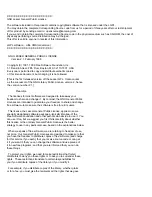
Avaya C360 Layer 2 Features
144 Installation and Configuration Guide Avaya C360 Multilayer Stackable Switches, version 4.5
IP Multicast Filtering
Overview
IP Multicast is a method of sending a single copy of an IP packet to multiple destinations. It can
be used by different applications including video streaming and video conferencing.
The Multicast packet is forwarded from the sender to the recipients, duplicated only when
needed by routers along the way and sent in multiple directions such that it reaches all the
members of the Multicast group. Multicast addresses are a special kind of IP addresses (class
D), each identifying a multicast group. Stations join and leave multicast groups using IGMP. This
is a control-plane protocol through which IP hosts register with their router to receive packets for
certain multicast addresses.
IP multicast packets are transmitted on LANs in MAC multicast frames. Traditional LAN
switches flood these multicast packets like broadcast packets to all stations in the VLAN. In
order to avoid sending multicast packets where they are not required, multicast filtering
functions may be added to the layer 2 switches, as described in IEEE standard 802.1D. Layer 2
switches capable of multicast filtering send the multicast packets only to ports connecting
members of that multicast group. This is typically based on IGMP snooping.
The C360 supports multicast filtering. The C360 learns which switch ports need to receive
which multicast packets and configures the necessary information into the switch's hardware
tables. This learning is based on IGMP (version 1 or 2) snooping.
The multicast filtering function in the C360 is transparent to the IP hosts and routers. It does not
affect the forwarding behavior apart from filtering multicast packets from certain ports where
they are not needed. To the ports that do get the multicast, forwarding is performed in the same
way as if there was no filtering, and the multicast packet will not be sent to any ports that would
not receive it if there was no filtering.
The multicast filtering function operates per VLAN. A multicast packet arriving at the device on a
certain VLAN will be forwarded only to a subset of the ports of that VLAN. If VLAN tagging mode
is used on the output port, then the multicast packet will be tagged with the same VLAN number
with which it arrived. This is interoperable with multicast routers that expect Layer 2 switching to
be done independently for each VLAN.
Summary of Contents for C360 Manager
Page 17: ...Issue 2 July 2005 17 Section 1 Avaya C360 Overview...
Page 18: ...18 Installation and Configuration Guide Avaya C360 Multilayer Stackable Switches version 4 5...
Page 29: ...Issue 2 July 2005 29 Section 2 Installing the C360...
Page 30: ...30 Installation and Configuration Guide Avaya C360 Multilayer Stackable Switches version 4 5...
Page 91: ...Issue 2 July 2005 91 Section 3 Avaya C360 Configuration...
Page 92: ...92 Installation and Configuration Guide Avaya C360 Multilayer Stackable Switches version 4 5...
Page 211: ...Issue 2 July 2005 211 Section 4 Troubleshooting and Maintaining the Avaya C360...
Page 212: ...212 Installation and Configuration Guide Avaya C360 Multilayer Stackable Switches version 4 5...
















































